Children's books
Reading to children and infants helps them experience the delight and enchantment of language and story. Reading aloud lets your child come to know your voice, your touch, the rhythm and the flow of language, and the power of pictures. Helen Keller thought of books as friends and invented the word "book-friends" because books were such an important part of her life.
In 2002, the Early Childhood Centre published a set of seven books, Books for Children and Families, to be used in conjunction with the Parenting for a Literate Community Program. This set is still available for sale as a stand along collection. With their engaging pictures and easy, repetitive texts, this collection explores various topics of interest to young children.
In 2003, the Centre partnered with Born to Read NB to do a province wide manuscript and illustrator search to create a book for babies. Since then five books have been produced: Kisses, Kisses, Kisses, Foggy Cat, Baby's Garden, A Lullaby for New Brunswick, and in May 2015, Bedda-bye Maritime Rhyme was launched.
These books are written and illustrated by New Brunswick residents and given out to new parents in the hospital.
How to order
Phone: (506) 453-5024
Fax: (506) 458-7841
eccentre@unb.ca
Children's books
A Lullaby for New Brunswick
Written by Jennifer Aikman-Smith | Illustrated by Chris Browne
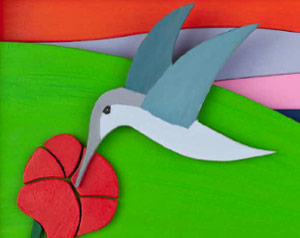
Sing your way around the province with this charming lullaby. Vibrant images and evocative language combine to celebrate the beauty and diversity of New Brunswick's landscape.
Note to parents
A Lullaby for New Brunswick takes us in word image from the Christmas Mountains in the north, along the Wulustuk (Saint John) River to Kings Landing and Grand Lake, then down to the port of Saint John, and into the Bay of Fundy. Here, the distinctive Hopewell Cape and the astonishing Fundy tides are highlighted. Then we head up the Northumberland Strait to Chaleur Bay and into the heard of Acadie where the Tintamarre, a "noisy parade" is held on August 15 to celebrate pride in Acadie.
Many New Brunswick place names are lyrical, poetic , and full of historical meaning. Miramichi translates as "home of the Mi'kmaq". The Miramichi River and its many tributaries flow through the heard of New Brunswick. Our forests and rivers echo with the earliest histories of the Mi'kmaq, Maliseet, and Passamaquoddy, meaning the "river of the tides", is the site of a beautiful sandy national park in the northeast of New Brunswick.
May the beautiful language and vibrant, three-dimensional images of this book bring you and your baby a sense of joy and wonder about New Brunswick, the language of place names, and the beauty of familiar sights.
Baby's Garden
Written by Karen Davidson | Illustrated by Patricia Tingley
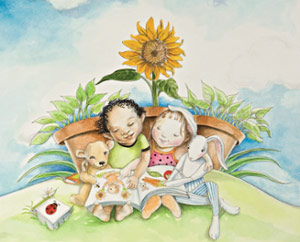
Baby's Garden is a delightful fantasy! From the raucous muddle puddle opening to the tender and quiet snowflake closing, the author and illustrator have created a visual and verbal work of art for all ages.
"Oodles of bears" and "berries jump juicy" are delicious examples of Karen Davidson's rhythmical phrases that invite child and adult alike to experience the deep pleasures of language. Patricia Tingley's visual interpretation of these poems exudes the warmth of friendship. Her thoughtfulness and humour shine through in her detailed illustrations of baby's ever-changing and ever enchanting garden.
Note to parents
Playing with language and carefully looking at pictures immerses very young children in the story grammar of books and the visual language of art. Some of the language created by the poet gives a sense of story, and some is playful nonsense. In the same way, the artists carefully crafted images invite exploration and interaction, with lots of opportunities for readers and viewers to create sound effects and actions.
The jury's selection of a book of poems expands our growing Born to Read New Brunswick collection. As poet Nikki Grimes loves to say: "There's no cooler place to be, than the land of poetry". We agree. This book is a poetic delight; carefully created to cast magical spells on young and old alike.
Bedda-bye Maritime Rhyme
Written by Beth Weatherbee | Illustrated by Chrissie Park-MacNeil
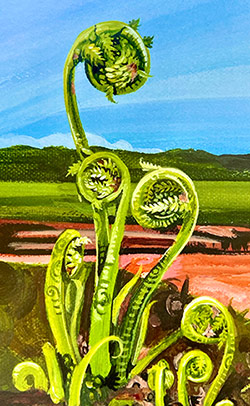
Bedda-bye Maritime Rhyme is a verbal and visual delight.
Beth Weatherbee’s lively word-play offers up familiar Maritime settings as filtered through the imagination. Her use of alliteration and rolling rhythms are complemented wonderfully by Chrissie Park-MacNeil’s swirling, twirling landscapes, seascapes, and cityscapes. Have a deliciously delightful time sharing Bedda-bye Maritime Rhyme with your baby.
Note to parents
As you read Bedda-bye Maritime Rhyme out loud, you may find your tongue tripping over alliterative, nonsensical phrases. Beth Weatherbee’s lively play with language brings the familiar and unfamiliar together with phrases like: “pumble-pum puffins,” “moosical moose,” “fireflies flickering,” and “dandelion dottering.” Her language demands to be performed, to become sound-play for you and your baby. Familiar with your voice, your baby will engage with the joy of sound as the two of you playfully explore the musicality of language.
Chrissie Park-MacNeil’s images trace the hot steam of muffins, the mist with the puffins, to grandiose greenery ad spellbinding scenery. Each image beautifully invites you into landscapes, seascapes, or skyscapes. The book’s language ad images work seamlessly-you can almost hear the roar of the tidal bore and taste the marvelous maple-y kiss. Reading then re-reading this engaging language, you will hear the music, and experience the soothing, sweeping, and familiar motions of the painted landscapes.
Have a deliciously delightful time sharing Bedda-bye Maritime Rhyme with your baby.
Chicka-chicka Chickadee
Come “flitting and flying” with chickadees across the season, as they build their nests, tend their families, stand as sentries, and “fluff puff” their feathers in wintry weather. Chrissie Park-MacNeil’s charming portraits and Kyla Brewer’s sing-songing language beautifully illustrate the daily habits of chickadees with their distinctive black caps, bibs, and fluffy white cheeks - little creatures who create their homes in the midst of ours.
Note to parents
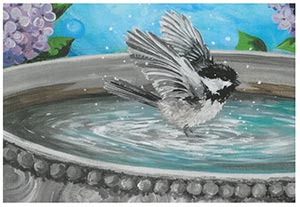
Chicka-chicka Chickadee animates the birdsong and energetic actions of the black-capped chickadee, New Brunswick’s official bird. This friendly, tiny bird whose habitat ranges across North America is a long-time year-round inhabitant of New Brunswick. Known as kocokikihlahsis in Wolastoqey, and k’at or g’at in Mi’kmaq, the chickadee is also a major character in The Bear and the Seven Hunters, one of the first stories from this land, recently re-told in book form by Elder George Paul of the Metepenagiag First Nation.
Lively and recognizable, the chickadee’s distinctive songs can be heard throughout the year. Illustrator Chrissie Park-MacNeil’s carefully crafted images bring Kayla Brewer’s lyrical language to life, animating chickadees across the seasons. Beginning with spring we are given a bird’s eye view into a hollow tree trunk where tiny spotted eggs are watched over by both parents, awaiting hatching. As the seasons pass, we can almost smell the lilacs by the bird bath and taste those little red berries. In winter the chickadee acts as a sentry for other birds, such as warblers, and nuthatches, alerting them to food and danger.
Enjoy this book as chickadees call you and your baby into the wonder and pleasures of their daily lives.
Foggy Cat
Written by Glenda Thornton | Illustrated by Robert Lyon
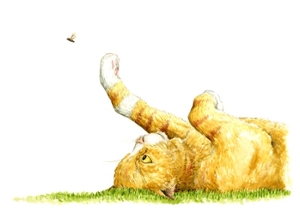
Robert Lyon's illustrative water colours combine beautifully with Glenda Thornton's rhythmic language. Together author and illustrator bring Foggy Cat's daily and seasonal life to the page. Enjoy the meanderings of Foggy Cat through the neighbourhood, the house, and the seasons.
Note to parents
Reading to infants helps them experience the delight and enchantment of language and story. Reading aloud lets your baby come to know your voice, your touch, the rhythm and the flow of language, and the power of pictures. Helen Keller thought of books as friends and invented the word book-friends because books were such an important part of her life.
Because young children often have an affinity for animals, many picture books case animals in the leading role. Foggy Cat bring us little sketches in the life of a cat; favourite places to sleep, to play, to groom, or to just laze about. Try making a variety of cat sounds - meowing, purring, growling, hissing. Playing with sounds is pleasurable and helps babies gain a sense of the underlying structures of language.
Foggy Cat is perfect for "reading" the pictures and making up stories. You might wonder out loud: what is the cat doing under the sink? or will it take his ball of yarn from the shelf and unwind it leaving a trail throughout the house? or will that buzzing bee find the cat? I hope not!
Kisses, kisses, kisses
Written by Darlene Ryan | Illustrated by Peter Manchester
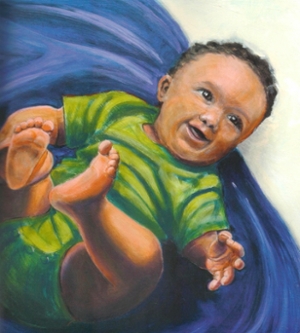
Peter Manchester's textured images combine with the poetic words of Darlene Ryan to re-create moments of affection between babies and ourselves.
Kisses, kisses, kisses reveals how a look, a touch, a bit of play, or sharing a book, acts as a kind of kiss, connecting us in intimate ways our babies.
Note to parents
Babies have many ways to make connections with us. They wiggle, coo, smile, cry, laugh, grasp our finger tightly, and look deep into our eyes.
Kisses, kisses, kisses encourages connecting with a child. Everyone who is part of a baby's life, both family - extended and blended - as well as friends, help teach the child about love, trust, and his or her place in the world.
Babies are very curious. They are eager to explore, to see, to touch, and learn. Visiting new places - indoors and outdoors - singing, talking, sharing simple rhymes, responding to their smiles and coos helps them to grow and connect with their worlds.
Wind Down Time Lullaby
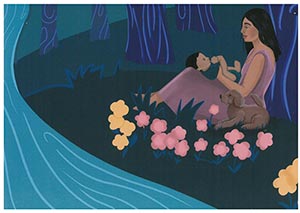
Shirley Downey lived her life in St. Stephen, New Brunswick, where she was a passionate and knowledgeable advocate of many things – especially the literacy of very young children. Inspired by a program in Quebec and supported by the Heritage Chapter of the Imperial Order of the Daughters of the Empire (IODE) she began Born to Read New Brunswick in St. Stephen. Born to Read NB became a provincial bilingual book-give-away program in 1997, and early literacy initiative with support from the Government of New Brunswick. Shirley is the author of Mud Muddelicious Mud, Puddle Jumping, and Fishes in the Sea. Wind Down Time Lullaby is her fourth picture book.
Lauren Polchies is a Wolastoqey illustrator and designer from Wotskak (Woodstock) First Nation. Her magical illustrations in this book were inspired by the New Brunswick landscape. The first part of the book, the verse, “Wind down time” takes place within the forest and along the shores and of the Wolastoq, also known as the Saint John River. The images of the lullaby section move through the sea and coastal areas of New Brunswick. Wind Down Time Lullaby is Lauren’s first children’s book.
We hope that you and your baby enjoy this beautiful book with Shirley Downey’s two-part rhyme and Lauren Polchies’s magical illustrations.
Shirley loved playing with language and understood the power of picture books, the cadence and music of their language, and the interactive artistry of the illustrations. Playing with language and looking at images from a very early age bonds babies with family members as together they reengage with the beauty and pleasure of the worlds created through words and images.
Lauren’s vibrant interpretation of Shirley’s words draws upon the warmth and softness of the night, of wind down time, and the beauty of the New Brunswick landscape and its many inhabitants. In particular, Lauren is inspired by life along the Wolastoq (also called the Saint John River) and within the coastal waters of what is now called New Brunswick. Our children are born into a place where families of all kinds have lived and played on the land, in the forest, and the sea for thousands of years. As a Wolastoquey artist Lauren’s illustrations attest to a deep respect for the shared land upon which all beings live. She weaves a tapestry of warmth, beauty, love and connectedness, and hope – perfect for Shirley’s words.
Books for children and families
With engaging pictures and easy, repetitive texts, this collection explores various topics of interest to young children. Each book includes information for parents and a list of related children's books. This collection grew out of research conducted at UNB and may be used in conjunction with the Parenting for a Literate Community Program or as a stand alone collection.
Seth Writes a Story
Written by Seth Buckley | Illustrated by J. O. Pennanen
This is a story within a story. As a boy falls to sleep writing a book, the characters lift off the page and begin an adventure of going for a walk in the evening woods before arriving home safely.
Seth Buckley was six years old when he wrote this story. The short and simple story gives us a hint of Seth's vivid imagination and his understanding of how stories are told.
Children learning how to read and write need lots of opportunity to have their words written down. Children have many brilliant stories in their heads. Their stories can be based on a special event like going to the dentist, an everyday event like cooking supper, or an adventure story like "Seth Writes a Story". Special songs or poems could also be written in a homemade book.
Children are highly motivated their own thoughts and printed words. Writing down a story that a child has told allows you to return to it over and over again. There are many ways that as a parent you can help a child get their words on a page. Some children can write words on their own, some can write a few familiar letters, and some prefer to dictate the word to you. Home made books have a way of becoming family treasures!
Careful, Corey!
Written by Pamela Nuttall Nason | Illustrated by George Fry
Helping with household tasks such as putting away the groceries allows children to feel confident in their growing abilities. Because of this, toddlers will take great pleasure in reading about Corey, a confident boy who brings his own style of help to putting away the groceries.
Product labels are some of the first words children recognize as they watch TV, go shopping, help with the cooking, or put away the groceries. Labels can provide an opening for children and adults to talk about the size and the colour of packages, whether an item is needed, and what their family can or cannot afford. As children engage in these conversations, with their endless questions of "why" and "what does that say?" they make important connections between print and their everyday lives.
As you read this book to your child, talk about what is going on in the pictures, point to the words and pause when you get to the phrase "Careful, Corey!", inviting your child to chime in. Soon they will be able to point and say the words "Careful, Corey!" all by themselves. And as they begin to associate the products with the labels, they'll be wanting to know what those words say too.
Going on a Number Hunt
Written by Pam Whitty | Illustrated by Mandy Wright
In this story, a young boy goes on a number hunt right in his very own home and finds numbers are everywhere! Join in with him as he counts from sun up to sun down and even on into the next day.
As a parent, you know how much fun your child can have counting out loud, counting the spoons on the table, the cans in the cupboard, or just saying the numbers out loud. When children first start to count, it is common to name the numbers out of order - 1, 2, 5, 8. When they begin to understand that each number stands for one object, they begin to count each object and name the numbers in the right order. Then your children may really want to go on a number hunt, counting everything.
Looking for numbers in your home like those on the remote control, or a clock, or a calendar helps children to match the number they are reciting to a number they can see. They can see what each number looks like.
Children also love to sing number songs like" One, Two, Buckle my Shoe". And they like to make up songs on their own or with you. They really love to count the steps they are taking as they walk down the street or the stairs they are climbing. When children take such pleasure in counting and naming numbers, they are learning. So enjoy counting with your children!
Wiggles, Squiggles, Lines & Jiggles
Written by Pam Whitty | Illustrated by Trish Tingley
This is a joyful book about a young girl who loves to make marks. She draws and writes indoors and out. She is learning about the power of writing her name and drawing pictures. And as she learns, she sometimes finds herself in funny situations that will make you laugh with recognition.
The first make that children make looks a lot like scribbles on the opening pages of this book. Over time as children have practice with crayons, pencils, markers, pens, and paint they begin to draw lines, shapes, and the human form. They also like to draw about their own experiences. They might draw about a trip to Grandma's or the park. Or they could decide to draw action scenes from their favourite TV shows or videos.
Children love to make marks. It is a powerful feeling to know you can make your mark on the world. As some of you know, children often make these first drawings and writing on a book or a wall. However, they quickly adjust to writing or drawing on paper, dirt, sand, or snow.
Writing and drawing area an important part of every child's literacy growth. In the beginning, writing and drawing may look the same, like lines and jiggles. Usually by age three, children will tell you the differences between their writing and their drawing. If you say to them, "Tell me about your drawing and writing" you may well be amazed with the stories you hear. When children have the chance to make and talk about their drawings and writing, they share their thoughts and feelings. They show and tell us their place in the world.
Singing & Dancing
Written by Anne Hunt | Illustrated by Kathy Hooper
The day is full of singing and dancing, sometimes joyful, sometimes angry. From morning until night the children and adults in the book sing and dance to share their feelings.
When we sing and dance with our children we share how we feel. The music and the movements come from emotions of the moments. Even before children can talk they can sing and dance. This kind of singing and dancing is not performance. It is a sharing of feelings.
We may sing a top 10 tune, a remembered song from our own childhood, a TV jingle, or something we make up on the spot. Our movements may be a particular dance step or a free response to the rhythm. Our dance may be as simple as the repeated rocking motion that fits so well with a lullaby.
Children can often sing more difficult sentences than they can speak. As we sing together, we are often playing with language. Sometimes, we make up new words to old tunes. We insert our child's name into familiar songs. We say counting songs like "The Ants Go Marching One by One". We also enjoy add on songs such as "There was an Old Lady Who Swallowed a Fly". Playing with words and rhythms is a great way for parents to support children's literacy development in natural, joyful ways.
I Am Starting School Today
Written by Pam Whitty | Illustrated by Jeneca Klausen
Starting school can be a great adventure - exciting and maybe a little anxious for children and parents. Join the hero of this story as she says 'bye to mom, and starts off to school in anticipation of riding the bus and making friends.
The story in this book comes from my conversations with many mothers. They told me that starting school can be an anxious event for children and their moms. As moms, they are worried about whether or not their child would get on the right bus to come home from school, make new friends, or find help on the playground if they had a problem. They asked, "Will my child be okay at school?".
Many of the moms said they had gotten ff to a bad start at school when they were children. They wanted their children to be okay, to feel safe. The moms liked when the school arranged to have the bus at kindergarten orientation. When their children could get on and off the bus, these moms felt more comfortable. They also appreciated teachers and principals who let them stay with their children in the classroom.
We know that children who have the chance to play with neighbourhood friends, attend high quality play groups or day care prior to kindergarten have an easier time starting school. They learn to get along with other children and to relate to adults who are not their parents. They also learn about reading, writing, and numbers in an informal way. They bring all this social and academic learning to the kindergarten classroom.
Baby and Mommy Go Walking
Written by Lynda Homer | Illustrated by Cheryl Bogart
Although I have loved my work, my best and most important job has been being a mother. I have wonderful memories of evening walks taken with my children when they were babies. My memories of these happy times have been the inspiration for this book.
When my sons were first born, they often had a cranky time after supper. Going for a walk outdoors provided healthy fresh air and a change for both of us. The motion of the stroller and the sights, sounds, and smells of the outdoors were calming. It gave us an opportunity to enjoy nature together and to share a very special time.
I hope you will enjoy reading this book to your baby. It is a rhyming story about mommy and baby going fo a walk. The rhythm of the words and the sounds of your voice can be soothing for your baby. The pages with full pictures show the many exciting things that are happening during the walk. These pictures can be a source of conversation and add meaning to the story. The pages with words have just one pictures you will notice that the word matching the picture is emphasized. You can point to the picture and show your baby as you say the word. Once your baby begins to focus on the page and has favourites, point and say can be fun.
